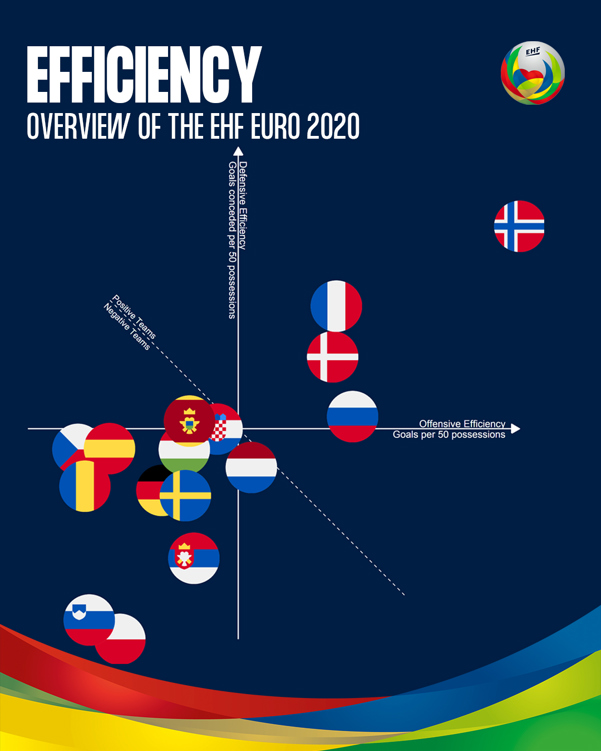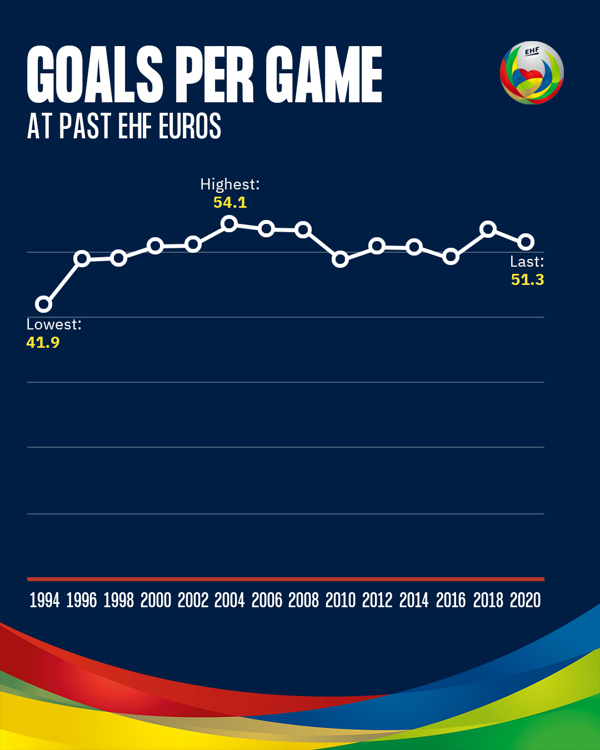With the Women's EHF EURO 2022 about to throw off, it is time to look at data of the last EHF EURO events to see what they say about the upcoming European Championship.
No matter who you ask, the top favourites for the upcoming EHF EURO are clear: Defending champions Norway, Olympic champions France, and, somewhere behind them, Denmark.
Fittingly, those three teams have also been the best by the numbers in recent tournaments compared to the other 13 participants in Slovenia, North Macedonia, and Montenegro.
In 2020, Norway dominated – especially offensively. They scored 28.1 goals per 50 possessions, by far the best number in the tournament and better than every team in the two EHF EUROs before. Maybe that even is an all-time best mark.
Led by goalkeeper Silje Solberg, who had the best save percentage at the last three EHF EUROs, they also had the best defence with only 20.1 goals conceded per 50 possessions.
Even in 2018, when they ended up in fifth place, they again topped the rankings at both ends of the court.

France, who won the EHF EURO in 2018 and were second in 2020, were very strong in attack and defence as well. In 2020, they had the third-best attack (25.1 goals per 50 possessions) and second-best defence (21.4 goals conceded per 50 possessions), while in 2018 it was the other way round.
After a moderate EHF EURO 2018 – according to the statistics – Denmark had the third-best defence with 22.2 goals conceded per 50 possessions as well as the fourth-best attack scoring 25.0 goals per 50 possessions two years later. With a further improvement, Jesper Jensen’s team could be the third top team behind the two favourites and secure their first medal at an EHF EURO since 2004.
However, it is not always the favourites who win the race. The best example, of course, are Croatia at the last EHF EURO. They were not good at all in 2016 (fourth-worst offence, worst defence) and 2018 (worst offence, third-worst defence), but managed to improve well enough on both sides.
In 2020, they had the sixth-best offence, scoring 23.1 goals per 50 possessions, as well as the sixth-best defence, conceding only 23.4 goals per 50 possessions. Nevertheless, both numbers were just around average.
But more importantly, they prevailed when it was important and thus managed to finish ahead of Denmark and Russia, who had significantly better statistics, in the final ranking.
Predicting such surprises from the numbers is extremely difficult, as the data from two years ago are only partially related to those of today’s teams.
Besides, teams that were already decent in recent EHF EUROs, such as the Netherlands or Sweden, wouldn’t really be surprises like Croatia were two years ago.
Surprises on the scale of Croatia would be, based on the data from two years ago, Slovenia or Poland. However, there is nothing in the numbers to suggest that they could make a big leap.
From the statistics at the EHF EURO 2020, Romania could also be included in this group. But a team with scoring machine Cristina Neagu at 100 per cent can hardly be called a big surprise.
Scoring machines are also needed to break an 18-year-old record. In 2004 in Hungary, the highest number of goals at a Women’s EHF EURO was scored: 2,596 in 48 games, or 54.1 goals per game. In recent years, the number of goals scored was well below that; in the last six tournaments the highest figure was 53.3 goals per game – in 2018.

Nevertheless, the signs for a new goal record are not bad. The number of goals scored depends on two factors: Attack efficiency and the number of possessions. While the offensive efficiency has been relatively stable, the number of possessions has been as well in recent years.
However, the pace of the game has increased remarkably this season due to the new rules. Because of the new throw-off area and the fewer passes allowed when passive play is indicated, handball has become faster.
In the EHF Champions League Women, each team had 55.5 possessions this season, an increase of 1.5 in comparison to last season. In the Machineseeker EHF Champions League, the increase even has been 2.8 possessions.
For a new record in overall goals, 55.3 goals must be scored per game. To achieve this, based on the attacking efficiency of the last EHF EURO, 58.9 possessions would be needed on average. However, since each team had 54.7 possessions per game at the EHF EURO 2020, this seems to be too big an increase.
Assuming the slightly higher offensive efficiency of 2018, only 56.5 possessions (an increase of 1.8) would be needed by each team. Both this increase and a slightly higher efficiency are realistic since the trend of handball becoming more efficient set in.
Looking only at goals per game, a new record is even more likely, because one game less will be played than in 2004. So, the increase in speed has a greater effect on this record than on the overall record.
With an attacking efficiency like in 2020, 57.7 possessions would be needed; if it is like 2018, only 55.3 would be needed. A new goal record seems within reach.
Julian Rux is a data analyst and data journalist. More of his work can be found on his website and blog Handballytics.de as well as on social media: Instagram, Facebook and Twitter.
Photo © Uros Hocevar / kolektiff








